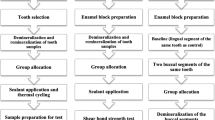Abstract
Objectives
The aim of this research was to analyse the dental discolouration caused by mineral trioxide aggregate (MTA) induced by bismuth oxide and also assess the colour stability of other dental cements.
Materials and methods
Bismuth oxide, calcium tungstate and zirconium oxide were placed in contact with sodium hypochlorite for 24 h after which they were dried and photographed. Phase analyses were performed by X-ray diffraction (XRD) of radiopacifiers before and after immersion in sodium hypochlorite. Furthermore, teeth previously immersed in water or sodium hypochlorite were filled with MTA Angelus, Portland cement (PC), PC with 20 % zirconium oxide, PC with 20 % calcium tungstate and Biodentine. Teeth were immersed for 28 days in Hank’s balanced salt solution after which they were sectioned and characterized using scanning electron microscopy (SEM) with energy-dispersive mapping and stereomicroscopy.
Results
Bismuth oxide in contact with sodium hypochlorite exhibited a change in colour from light yellow to dark brown. XRD analysis demonstrated peaks for radiopacifier and sodium chloride in samples immersed in sodium hypochlorite. The SEM images of the dentine to material interface showed alteration in material microstructure for MTA Angelus and Biodentine with depletion in calcium content in the material. The energy-dispersive maps showed migration of radiopacifier and silicon in dentine.
Conclusions
MTA Angelus in contact with a tooth previously immersed in sodium hypochlorite resulted in colour alteration at the cement/dentine interface.
Clinical relevance
MTA Angelus should not be used after irrigation with sodium hypochlorite as this will result in tooth discoloration.






Similar content being viewed by others
References
Torabinejad M, White DJ (1995) Tooth filling material and use. US Patent Number 5,769,638
Torabinejad M, Hong CU, McDonald F, Pitt Ford TR (1995) Physical and chemical properties of a new root-end filling material. J Endod 21:349–353
Farsi N, Alamoudi N, Balto K, Al Mushayt A (2006) Clinical assessment of mineral trioxide aggregate (MTA) as direct pulp capping in young permanent teeth. J Clin Pediatr Dent 31:72–76
Bortoluzzi EA, Araújo GS, Guerreiro Tanomaru JM, Tanomaru-Filho M (2007) Marginal gingiva discoloration by gray MTA: a case report. J Endod 33:325–327
Jacobovitz M, Pontes Lima RK (2009) The use of calcium hydroxide and mineral trioxide aggregate on apexification of a replanted tooth: a case report. Dent Traumatol 25:e32–e36
Belobrov I, Parashos P (2011) Treatment of tooth discoloration after the use of white mineral trioxide aggregate. J Endod 37:1017–1020
Felman D, Parashos P (2013) Coronal tooth discoloration and white mineral trioxide aggregate. J Endod 39:484–487
Primus CM (2011) Dental material. US Patent Number 7892342 B2
Boutsioukis C, Noula G, Lambrianidis T (2008) Ex vivo study of the efficiency of two techniques for the removal of mineral trioxide aggregate used as a root canal filling material. J Endod 34:1239–242.4
Lenherr P, Allgayer N, Weiger R, Filippi A, Attin T, Krastl G (2012) Tooth discoloration induced by endodontic materials: a laboratory study. Int Endod J 45:942–949
Ioannidis K, Mistakidis I, Karagiannis V (2013) Spectrophotometric analysis of coronal discolouration induced by grey and white MTA. Int Endod J 46:137–144
Akbari M, Rouhani A, Samiee S, Jafarzadeh H (2012) Effect of dentin bonding agent on the prevention of tooth discoloration produced by mineral trioxide aggregate. Int J Dent 563203
Vallés M, Mercadé M, Duran-Sindreu F, Bourdelande JL, Roig M (2013) Influence of light and oxygen on the color stability of five calcium silicate-based materials. J Endod 39:525–528
Camilleri J (2014) Color stability of white MTA in contact with hypochlorite solution. J Endod 40:436–440
van der Burgt TP, Plasschaert AJ (1985) Tooth discoloration induced by dental materials. Oral Surg Oral Med Oral Pathol 60:666–669
Wegehaupt F, Gries D, Wiegand A, Attin T (2008) Is bovine dentine an appropriate substitute for human dentine in erosion/abrasion tests? J Oral Rehabil 35:390–394
Pires-de-Souza FCP, Garcia LFR, Roselino LMR, Naves LZ (2011) Color stability of silorane-based composites submitted to accelerated artificial ageing-An in situ study. J Dent 39:e18–e24
Ablal MA, Adeyemi AA, Jarad FD (2013) The whitening effect of chlorine dioxide-an in vitro study. J Dent 41:e76–e81
Camargo CHR, Siviero M, Camargo SEA, de Oliveira SHG, Carvalho CAT, Valera MC (2007) Topographical, diametral and quantitative analysis of dentin tubules in the root canals of human and bovine teeth. J Endod 33:422–426
Camilleri J, Grech L, Galea K, Keir D, Fenech M, Formosa L, Damidot D, Mallia B (2014) Assessment of porosity and sealing ability of tricalcium silicate-based root-end filling materials. Clin Oral Investig. In Press
Han L, Okiji T (2011) Uptake of calcium and silicon released from calcium silicate-based endodontic materials into root canal dentine. Int Endod J 44:1081–1087
Formosa LM, Damidot D, Camilleri J (2014) Mercury intrusion porosimetry and assessment of cement-dentin interface of anti-washout type mineral trioxide aggregate. J Endod 40:958–963
Acknowledgments
Authors acknowledged the University of Malta Research Grant committee and the Faculty of Dental Surgery for the funding; Ing. James Camilleri of the Department of Metallurgy and Materials Engineering, Faculty of Engineering, University of Malta for his technical expertise; and ERDF (Malta) for the financing of the testing equipment through the project: “Developing an Interdisciplinary Material Testing and Rapid Prototyping R&D Facility” (Ref. no. 012). This work was supported by the State of São Paulo Research Foundation (FAPESP 2013/04054-8 and 2011/13573-3).
Conflict of interest
The authors declare that they have no conflict of interest.
Author information
Authors and Affiliations
Corresponding author
Rights and permissions
About this article
Cite this article
Marciano, M.A., Duarte, M.A.H. & Camilleri, J. Dental discoloration caused by bismuth oxide in MTA in the presence of sodium hypochlorite. Clin Oral Invest 19, 2201–2209 (2015). https://doi.org/10.1007/s00784-015-1466-8
Received:
Accepted:
Published:
Issue Date:
DOI: https://doi.org/10.1007/s00784-015-1466-8




